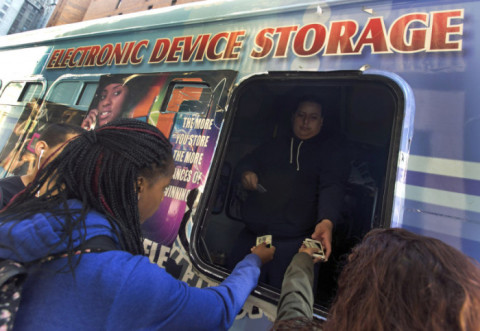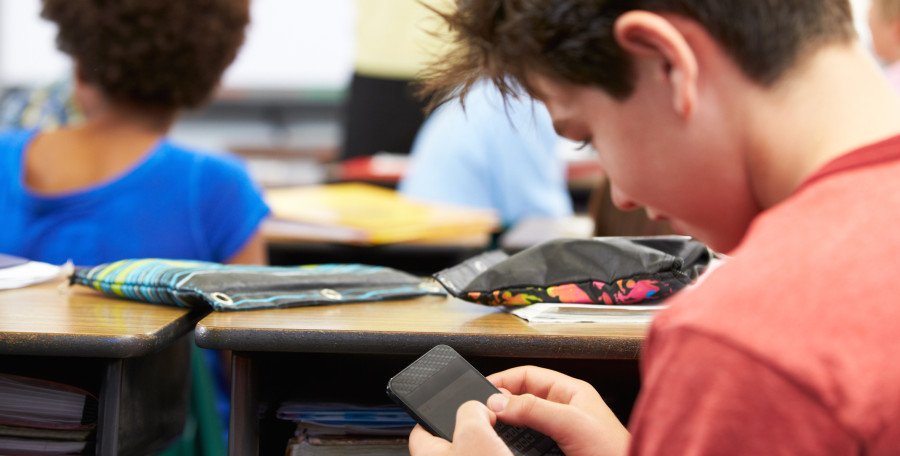Although students have been using cell phones consistently in their daily lives for almost a decade, many public schools continue to resist allowing the devices into the classroom. Schools generally grapple with new technologies, but cell phones' reputation as a nuisance and a distraction has been hard to dislodge.
Recently, however, the acceptance of these devices has been growing. Beginning in March, New York City, the largest school district in the country with 1.1 million students, will reverse its long standing ban on cell phones in schools.
The ban, which was implemented by the Bloomberg administration, went into effect in 2006, but Mayor Bill De Blasio championed the policy change, saying that he thought it was important for parents to be able to easily contact their kids.
Will more districts around the country follow? Liz Kolb, an assistant professor at the University of Michigan School of Education and author of Toys to Tools: Connecting Student Cell Phones to Education, says its already happening. According to Kolb, close to 70 percent of schools that had cell phone bans in place five years ago are reversing their policies.
 Students from Norman Thomas High School in New York City pay a dollar to check their electronic devices at a van before school.
Students from Norman Thomas High School in New York City pay a dollar to check their electronic devices at a van before school.
“First it was a very slow domino fall, and now we're seeing more of a tidal wave,” Kolb explains. “Part of it is because it’s hard to fight the tidal wave and there’s so many students with cell phones. The second part is that they’re really seeing them as a learning tool, not just a toy for entertainment, and they’re seeing that they can be cost effective for the schools instead of having to purchase technology for students.”
Critics believe, however, that allowing these devices will only encourage their non-educational use in school, to the point where they will be a significant distraction for teachers and students - and a potential tool for cheating. A specific concern for parents and educators is that lifting the cell phone ban could foster cyberbullying and sexting during school hours. NYC school officials are already taking steps to combat this, hoping to decrease the amount of sexting and cyberbullying overall.
Educators continue to have mixed opinions about cell phones in the classroom. We recently posed the question on the NEA Today Facebook page and received a wide variety of responses.
Are Students Addicted to Cell Phones?
Concerns about cell phones in the classroom are also grounded in what we know about teenage brains, including the inability to concentrate while multitasking and possibly long-term effects on overall health.
In Becky Dieffenbach’s opinion, bringing their own devices “just becomes a source of distraction for some students, because no matter how many times you repeat the rule that they can only be on technology when the teacher says it's ok, they choose to ignore the rule and then disciplinary actions have to be enforced.”
“Students persistently use them a great deal for personal interactions via social media when they should be paying attention to what is going on in class,” according to Connie Fawcett, a high school teacher in Oklahoma.
Based on her personal experiences, Fawcett “can see few positives outcomes for cell phones in the classroom, but it is becoming the new norm. Learning is going to suffer even more. What students gain from using them to support instruction will be lost due to the distraction factor, which appears to be much more appealing and fulfilling to many.”
Other teachers disagree and urge educators to accept the inevitability of cell phones in school and learn how to make them work in the classroom.
“We need to stop pushing against the technology and start embracing it,” says Amber Schaefer, an elementary school teacher in Minnesota. “The more we push back, the more we separate ourselves from students. It is time to incorporate and collaborate instead of ban and punish.”
“It would be nice if they weren't part of the school picture," adds New York teacher Barbara McConnell, "but they are, so let's use them to our advantage.”
Beyond the classroom, many educators believe that banning any type of technology can foster inequity. In New York City specifically, the school ban on cell phones was most stringently applied in schools with metal detectors, which also happen to be those with the highest concentrations of low-income and minority students.
José Vilson, a middle school math teacher in New York City and author of This Is Not A Test: A New Narrative on Race, Class and Education, agrees that these bans widen the gap between disadvantaged students and their peers. He believes forbidding cell phones just limits students’ access to technology, especially for those who attend urban schools.
Ending the ban in New York will mean students can “carry their cell phones into the building and not be treated like criminals and have to pay extra to leave it outside at the cellphone truck,” Vilson says.
Vilson, who uses all kinds of devices in his own classroom, doesn't believe that phones provide “much more of a distraction than kids already have. It depends on how [educators] approach the whole process.”
Once the new policy is in place starting in March, individual schools in New York City will be able to establish their own specific policies regarding cell phone use in the classroom, leaving many teachers to determine how they will react to the devices in hallways and classrooms.
Experts advise a cautious and well-researched approach. Liz Kolb urges schools to “start small."
“Don’t feel as if because students have the devices they have to be using them all the time," she explains. "They just really need to be careful and thoughtful and take baby steps, and develop a nice protocol and rules and structures for how students physically handle the device in the classroom.”
Kolb points to some schools in Michigan that adopted new straightforward rules and guidelines for educators that were designed to meet the needs of students while addressing educators’ concerns. Posted on classroom doors, for example, are signs indicating whether the students can use their devices. A green stoplight means they can use them; red means no.
“This allows students to know the expectations, and it also gives teachers autonomy over whether they’re going to use the cell phones,” Kolb explains. “It gives them a little bit of freedom. It’s a very simple policy, but it’s also very effective.”
Photos: Associated Press





